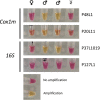LAMP-based molecular sexing in a gonochoric marine bivalve (Macoma balthica rubra) with divergent sex-specific mitochondrial genomes
- PMID: 37636868
- PMCID: PMC10450836
- DOI: 10.1002/ece3.10320
LAMP-based molecular sexing in a gonochoric marine bivalve (Macoma balthica rubra) with divergent sex-specific mitochondrial genomes
Abstract
Taking advantage of the unique system of doubly uniparental inheritance (DUI) of mitochondria, we developed a reliable molecular method to sex individuals of the marine bivalve Macoma balthica rubra. In species with DUI (~100 known bivalves), both sexes transmit their mitochondria: males bear both a male- and female-type mitogenome, while females bear only the female type. Male and female mitotypes are sufficiently divergent to reliably PCR-amplify them specifically. Loop-mediated isothermal amplification (LAMP) is a precise, economical and portable alternative to PCR for molecular sexing and we demonstrate its application in this context. We used 154 individuals sampled along the Atlantic coast of France and sexed microscopically by gonad examination to test for the congruence among gamete type, PCR sexing and LAMP sexing. We show an exact match among the sexing results from these three methods using the male and female mt-cox1 genes. DUI can be disrupted in inter-specific hybrids, causing unexpected distribution of mitogenomes, such as homoplasmic males or heteroplasmic females. To our knowledge, DUI disruption at the intra-specific scale has never been tested. We applied our sexing protocol to control for unexpected heteroplasmy caused by hybridization between divergent genetic lineages and found no evidence of disruption in the mode of mitochondrial inheritance in M. balthica rubra. We propose LAMP as a useful tool to accelerate eco-evolutionary studies of DUI. It offers the opportunity to investigate the potential role of, previously unaccounted-for, sex-specific patterns such as sexual selection or sex-specific dispersal bias in the evolution of free-spawning benthic species.
Keywords: DUI; Macoma balthica; heteroplasmy; loop‐mediated isothermal amplification; mitochondrial DNA; sexing.
© 2023 The Authors. Ecology and Evolution published by John Wiley & Sons Ltd.
Figures



Similar articles
-
Variability of mitochondrial ORFans hints at possible differences in the system of doubly uniparental inheritance of mitochondria among families of freshwater mussels (Bivalvia: Unionida).BMC Evol Biol. 2019 Dec 19;19(1):229. doi: 10.1186/s12862-019-1554-5. BMC Evol Biol. 2019. PMID: 31856711 Free PMC article.
-
Deciphering the Link between Doubly Uniparental Inheritance of mtDNA and Sex Determination in Bivalves: Clues from Comparative Transcriptomics.Genome Biol Evol. 2018 Feb 1;10(2):577-590. doi: 10.1093/gbe/evy019. Genome Biol Evol. 2018. PMID: 29360964 Free PMC article.
-
Natural Heteroplasmy and Mitochondrial Inheritance in Bivalve Molluscs.Integr Comp Biol. 2019 Oct 1;59(4):1016-1032. doi: 10.1093/icb/icz061. Integr Comp Biol. 2019. PMID: 31120503
-
Doubly uniparental inheritance: two mitochondrial genomes, one precious model for organelle DNA inheritance and evolution.DNA Cell Biol. 2009 Feb;28(2):79-89. doi: 10.1089/dna.2008.0807. DNA Cell Biol. 2009. PMID: 19196051 Review.
-
Embryo sexing and sex chromosomal chimerism analysis by loop-mediated isothermal amplification in cattle and water buffaloes.J Reprod Dev. 2013;59(4):321-6. doi: 10.1262/jrd.2013-028. J Reprod Dev. 2013. PMID: 23965599 Free PMC article. Review.
References
-
- Becquet, V. , Simon‐Bouhet, B. , Pante, E. , Hummel, H. , & Garcia, P. (2012). Glacial refugium versus range limit: Conservation genetics of Macoma balthica, a key species in the Bay of Biscay (France). Journal of Experimental Marine Biology and Ecology, 432, 73–82. 10.1016/j.jembe.2012.07.008 - DOI
-
- Breton, S. , Capt, C. , Guerra, D. , & Stewart, D. (2018). Sex‐determining mechanisms in bivalves. In Leonard J. (Ed.), Transitions between sexual systems (pp. 165–192). Springer. 10.1007/978-3-319-94139-4_6 - DOI
LinkOut - more resources
Full Text Sources

